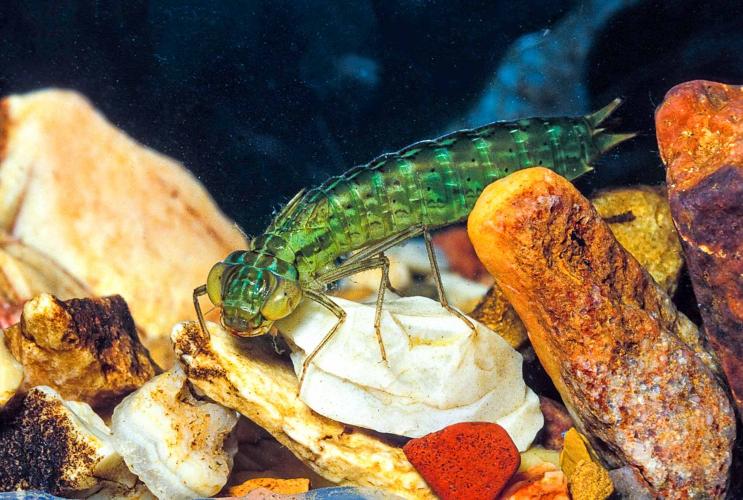Gossamer wings, iridescent colors, and dazzling maneuverability make dragonflies and damselflies some of the world’s most recognizable and intriguing flying insects.
In 2005, MDC reported that 136 species out of 450 in North America made their home in Missouri. MDC Aquatic Resource Scientist Brett Landwer said that number has increased in the ensuing years, as additional species of the insect order Odonata — dragonflies (Anisoptera) and damselflies (Zygoptera) — continue to be reported.
“Some are migrants or vagrants that don’t regularly breed in Missouri. Odonata are among our most primitive insects,” Landwer said, explaining that they are unable to fold their wings back over their long abdomen, an evolved characteristic common to most winged insects.
The length of the dragonfly’s abdomen helps balance the weight of its large wings and makes it more aerodynamic. Dragonfly families often are identified by colorful names based on various characteristics, including clubtails, petaltails, biddies, darners, skimmers, and cruisers.
“Missouri is home to the gray petaltail, a dragonfly from one of the most primitive groups,” Landwer said.
Gray petaltails vary little from dragonflies that filled the sky during the Carboniferous Period 300 million years ago. While most dragonfly and damselfly larvae are aquatic, petaltail larvae can live out of the water in wet leaves around sunny, shallow forest pools where adults lay eggs. A large dragonfly, the petaltail’s coloring — all grays and blacks — gives it excellent camouflage on tree trunks.
“The common whitetail skimmer gets my vote for the most common dragonfly in Missouri,” Landwer said.
As its name suggests, the male common whitetail has a chalky white, uniquely flat abdomen, which it uses to warn the competition out of its flooded habitat and pond territory. Females have brown wingtips and brown abdomens.
“The most easily recognized damselfly is probably the ebony jewelwing. It has black wings and a metallic blue body,” Landwer said, and added that the American rubyspot damselfly also is a large and colorful damselfly easily identified by the red spot at the base of its wings.
Dragon or Damsel?
Many people, including some in the scientific community, consider dragonflies and damselflies to be virtually the same winged critters, but there are some identifiable differences.
Dragonflies are generally a little brawnier than damselflies and have large eyes that touch or nearly touch. Damselfly eyes are separated, appearing on the sides of their heads.
When at rest, dragonfly wings are held horizontally. Most damselflies hold their wings together above their thorax and abdomen when they’re taking a break. Spreadwing damselflies are an exception.
Dragonflies also are much more robust navigators with larger, more broad-based rear wings. Damselflies’ smaller wings are equal sized with a teardrop shape. Their smaller flight muscles make their progress a little more irregular.
Fearsome Predators
In flight, dragonflies form a sort of “basket” with their hairy legs and feet to catch prey. Flying at speeds up to 30 miles per hour, they easily hover and make 360-degree turns to both capture prey and avoid becoming prey. Mosquitoes and other flying insects stand little chance of avoiding a hungry dragonfly.
“Dragonflies can control each of their wings independently while a majority of insects have to pull their entire thorax down to release their wings when they fly,” Landwer said of the insect’s extreme flight control.
Additionally, a dragonfly’s eyes are made up of nearly 30,000 optical units, or facets, called ommatidia, allowing them to detect the slightest movement in all directions simultaneously, adding to their hunting prowess.
“For being such a primitive animal, it’s amazing how complex their eyes are,” said Amy Meier, MDC Stream Team biologist. “One study showed they were 90 to 95 percent efficient in clearing an enclosure of mosquitoes.”
Dragonflies have hinged jaws that open as wide as the width of their head. They use them to clamp onto prey and shred it, sometimes dining in mid-air. The name Odonata is derived from Greek that means “toothed,” referring to the dragonfly’s serrated teeth. Dragonflies and damselflies pose no danger to humans.
A Heart Without Romance
Male dragonflies and damselflies recognize same-species females’ larval habitat of preference and set up territories to waylay perspective mates.
“Any time a female comes close, she’s harassed,” Landwer said. “Territory depends on the dragonfly. Hine’s emeralds will take over an entire fen and green darners will dominate an entire pond. A blue dasher will set up a territory and patrol it. It perches on weeds with a characteristic ‘tail up’ posture.” Few dragonflies have courtship rituals. Once a male identifies a potential mate based on her size, coloration, markings, and flight style, he intercepts her from behind with his legs. The male dragonfly subdues the female by grabbing her head behind her eyes with forceps-like anal appendages called cerci. Male damselflies clutch mates behind their heads. This in-air coupling is called tandem linkage
“Mating is very unromantic,” Meier said. “It can injure the female.”
While linked, the male’s sperm originates from his ninth abdominal segment while his reproductive organ is in the second segment. He has to bend his abdomen up to transfer sperm.
The female shows her consent — sometimes with encouragement from the male — by bringing the end of her thorax in contact with the male’s, forming a closed circle. This has been termed the wheel formation, a shape that also bears resemblance to a heart.
Fertilization takes place in the air or a nearby perch. Male dragonflies can scoop the sperm of recent mating predecessors from the female’s body and replace it with their own. “Sometimes mating dragonflies will stay attached until the female lays her eggs so that other males don’t mate with her,” Landwer said. “Green darners lay eggs in the tandem formation.”
Others will stay with the female until she lays her eggs, fending off competitors.
“More primitive species, like darners and petaltails, lay their eggs in aquatic vegetation. Spiketails lay eggs in sand. More advanced species lay their eggs directly into the water,” Landwer said.
Females lay thousands of eggs over a large area.
Life Cycle: Hatch to the Split
Many dragonfly eggs hatch in two to five weeks and others won’t hatch until the following spring. Some damselflies can have several generations in one season.
“Dragonfly and damselfly larvae are referred to as nymphs,” Landwer said. “But I am partial to the older term naiads because they live in the water.
“Dragonfly nymphs have a rectal gill chamber. They use it to propel themselves by expelling water. Damselfly nymphs have tracheal gills. They exchange gases across the surface of their gills and swim by undulating side-to-side.
“Some dragonfly larvae can be fairly large. Biddies [also known as spiketails] are terrifying because they are about as big as your thumb and have a mask of jagged teeth covering their faces,” Landwer said.
Larvae will eat anything they can catch and subdue — baby tadpoles and salamanders, microcrustaceans, small fish, and other aquatic larvae, including mosquitoes. The lower lip of the nymphs is a hinged appendage that is snapped outward with deadly precision to snag or spear prey. Dragonflies and damselflies are the only insects with this ability. A close-up look at them in action can be frightening.
“Dragonfly larvae molt eight to 13 times, depending on the species. The Hine’s emerald takes four years from egg to adult. They have a slow metabolism. They live in crayfish burrows alongside their most deadly predator,” said Landwer. “Spot-winged gliders can go from egg to adult in about 30 days because they live in small bodies of water that may dry up.”
The phases between molts are called instars. The final instar crawls out of the water and literally splits open, with the adult body emerging from the back of the larval shell like a telescope, often at night. Newly emerging adults are called teneral and are soft and flexible. Their wrinkled wings spread out and begin to harden over a couple of hours.
“It’s amazing. They can basically live as adults inside their larval skin,” Landwer said.
In the morning, the newly emerged adults fly to a treetop to completely harden and then forage for a couple of weeks before returning to water to breed.
Adult North American dragonflies generally live from two to four weeks; however, a lifespan exceeding 50 days has been recorded for the giant spreadwinged damselfly.
Sometimes Tenuous Existence
Landwer said that dragonfly larvae are not as sensitive to pollution as a lot of other aquatic insects, but some species have very specific habitat requirements that make them vulnerable to environmental changes.
Nine dragonfly species are listed as Species of Concern in Missouri and one, the Hine’s emerald, is listed as federally endangered. A large dragonfly with a 3-inch-plus wingspan, Hine’s have bright green eyes and a dark body with yellow stripes. Once believed to be extinct, the species was rediscovered in Illinois and Wisconsin, and a small population was found in the southeastern Ozarks in 1999. Since then, by investigating similar habitat conditions, additional populations have been identified in Missouri.
“Dragonfly larvae consume larval mosquitoes and adults eat mosquitoes and other insects. I truly believe, hands down, that dragonflies are the most beneficial insect for humans,” Meier said. “Anything we can do to preserve their habitat helps us.”
Learn More and Participate
Dragonflies Thermoregulate
Like most insects, dragonflies are ectotherms, which means they are at Mother Nature’s mercy when it comes to temperature regulation. However, these amazing insects have developed a couple of workarounds. A rapid whirring of their wings can actually warm them up. They also can tilt their large wings to soak up the sun’s rays or deflect the sun’s heat.
Some Dragonflies Migrate
Although there is still a lot to discover about dragonflies’ migratory habits, it is known that a few dozen North American species migrate south in great numbers, creating a magnificent spectacle. Northward spring migrations have been less documented. The best-known migration is that of the common green darner.
All green darners have a bright green thorax. Immature males and females have red or purple abdomens. Mature females’ abdomens are reddishbrown with males sporting blue abdomens.
Citizen Science
The Xerces Society is asking citizen scientists to help them observe dragonflies on the move. To participate, visit migratorydragonflypartnership.org.


















Also In This Issue


And More...
This Issue's Staff
Editor - Angie Daly Morfeld
Associate Editor - Larry Archer
Staff Writer - Bonnie Chasteen
Staff Writer - Heather Feeler
Staff Writer - Kristie Hilgedick
Staff Writer - Joe Jerek
Art Director - Cliff White
Designer - Shawn Carey
Designer - Les Fortenberry
Designer - Marci Porter
Photographer - Noppadol Paothong
Photographer - David Stonner
Circulation - Laura Scheuler






















